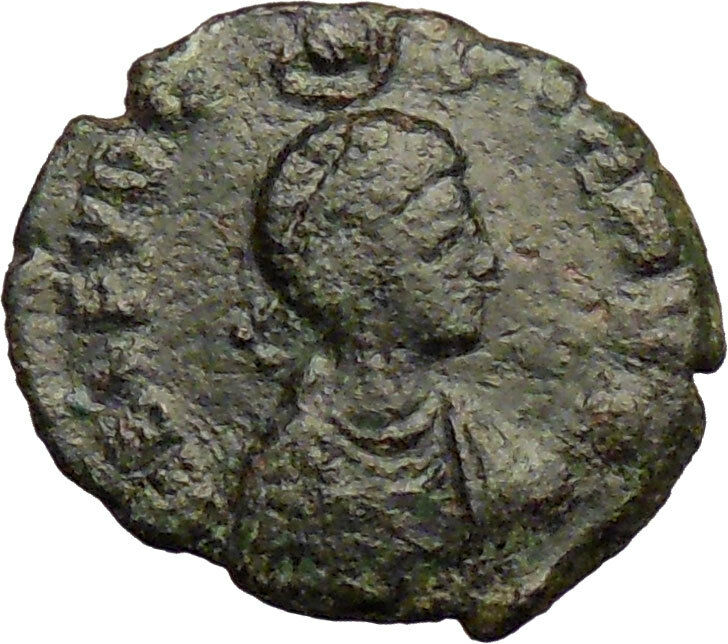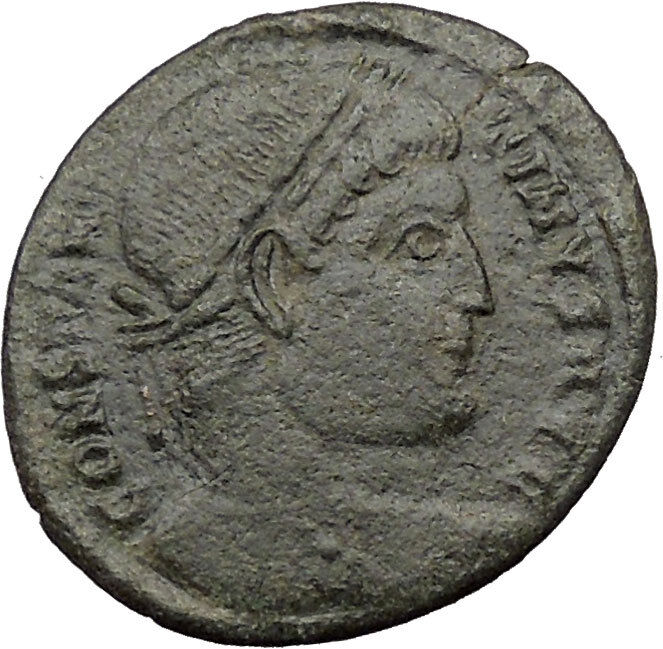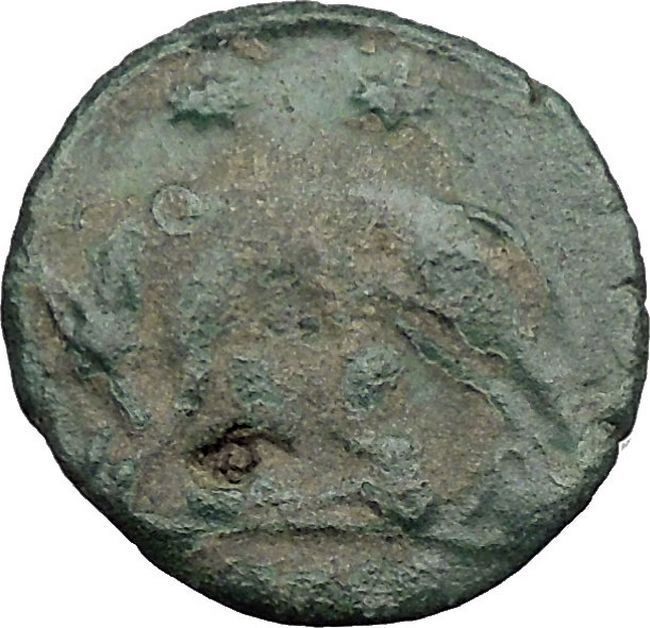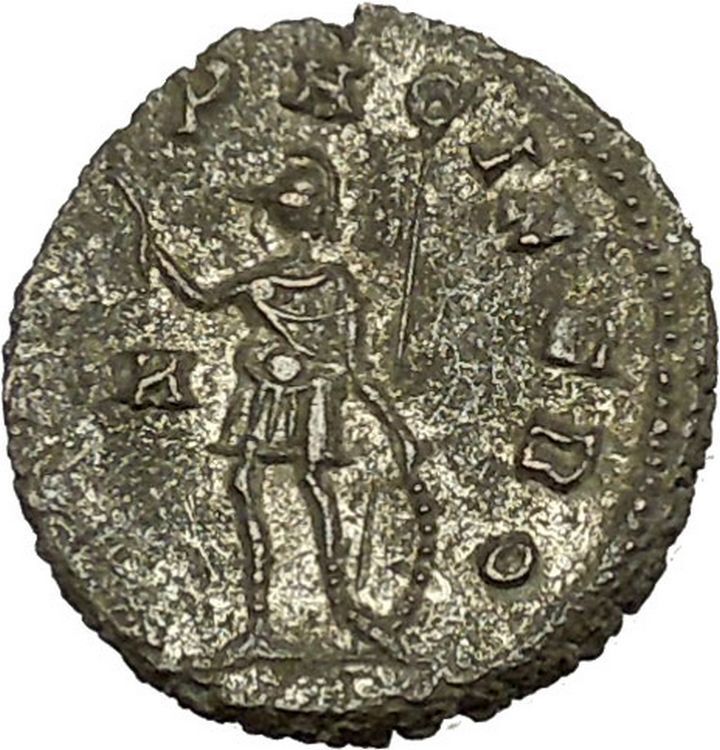|
Constantius II – Roman Emperor: 337-361 A.D. –
Bronze AE4 14mm (1.65 grams) Struck at the mint of Antioch 347-348 A.D.
Reference: RIC 113 (VIII, Antioch)
DNCONSTANTIVSPFAVG – Diademed (pearls) head right.
VOT/XX/MVLT/XXX Exe: SMANA – Wreath, legend within.
You are bidding on the exact item pictured,
provided with a Certificate of Authenticity and Lifetime Guarantee of
Authenticity.

A laurel wreath is a circular
wreath made of interlocking branches and leaves
of the
bay laurel (Laurus nobilis), an aromatic
broadleaf evergreen, or later from spineless butcher’s broom (Ruscus
hypoglossum) or cherry laurel (Prunus
laurocerasus). In
Greek mythology,
Apollo is represented wearing a laurel wreath
on his head. In
ancient Greece wreaths were awarded to victors,
both in athletic competitions, including the ancient
Olympics made of wild olive-tree known as “kotinos”
(κότινος), (sc. at
Olympia) and in poetic meets; in
Rome they were symbols of martial victory,
crowning a successful commander during his
triumph. Whereas ancient laurel wreaths are
most often depicted as a
horseshoe shape, modern versions are usually
complete rings.
In common modern
idiomatic usage it refers to a victory. The
expression “resting on one’s laurels” refers to someone relying entirely on
long-past successes for continued fame or recognition, where to “look to one’s
laurels” means to be careful of losing rank to competition.
Academic use
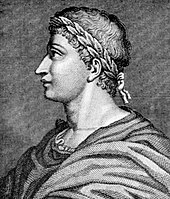
Ovid with laurel wreath, common in
poets.
In some countries the laurel wreath is used as symbol of the
master’s degree. The wreath is given to young
masters in the
graduation ceremony of the university. The word
“Laureate”
in ‘poet
laureate’ refers to being signified by the laurel wreath. The
medieval Florentine poet and philosopher
Dante Alighieri,[dubious
–
discuss] a graduate of the
Sicilian School, is often represented in
paintings and sculpture wearing a laurel wreath.
Laureato[3]
is the term used in
Italy to refer to any graduated student. In
some italian regions (Veneto,
Friuli-Venezia Giulia and
Trentino), right after the graduation ceremony
(in Italian: laurea), the student receives a laurel wreath and is allowed
to wear it for the rest of the day. This tradition was born in the
University of Padua and since the end of the
19th century is common to all
northeastern Italian universities.
At
Connecticut College in the United States,
members of the junior class carry a laurel
chain, which the seniors pass through during
commencement. It represents nature and the continuation of life from year to
year. Immediately following commencement, the junior girls write out with the
laurels their class year, symbolizing they have officially become seniors and
the cycle will repeat itself the following spring.
At
Mount Holyoke College in
South Hadley, Massachusetts, United States,
laurel has been a fixture of
commencement traditions since 1900, when
graduating students carried or wore laurel wreaths. In 1902, the chain of
mountain laurel was introduced; since then,
tradition has been for seniors to march across campus, carrying and linked by
the chain. The mountain laurel represents the
bay laurel used by the
Romans in wreaths and crowns of honor.[4]
At
Reed College in
Portland, Oregon, United States, members of the
senior class receive laurel wreaths upon submitting their senior
thesis in May. The tradition stems from the use
of laurel wreaths in athletic competitions; the seniors have “crossed the finish
line,” so to speak.
At
St. Mark’s School in
Southborough, Massachusetts, students who
successfully complete three years of one classical language and two of the other
earn the distinction of the Classics Diploma and the honor of wearing a laurel
wreath on Prize Day.
In
Sweden, those receiving a Doctorate or an
Honorary Doctorate at the Faculty of Philosophy
(meaning Philosophy, Languages, Arts, History and Social Sciences), receive a
laurel wreath during the ceremony of conferral of the degree.
Architectural and decorative arts motif

“Victory, A Knight Being Crowned With A Laurel Wreath” by
Frank Dicksee.
The laurel wreath is a common motif in
architecture,
furniture, and
textiles. The laurel wreath is seen carved in
the stone and decorative plaster works of
Robert Adam, and in
Federal,
Regency,
Directoire, and
Beaux-Arts periods of architecture. In
decorative arts, especially during the
Empire period, the laurel wreath is seen woven
in textiles, inlaid in marquetry, and applied to furniture in the form of gilded
brass mounts.
Alfa Romeoo added a laurel wreath to their
logo after they won the inaugural Automobile World Championship in
1925 with the
P2 racing car.
Flavius Iulius Constantius, known in English as
Constantius II (7 August 317 – November 3 361) was a
Roman
Emperor (337-361) of the
Constantinian dynasty.
 Constantius joins the lengthy list of emperors whose career Constantius joins the lengthy list of emperors whose career
was marked by a seemingly endless series of wars both domestic and foreign. He
served as Caesar from 324 until his father’s death in 337 at which time he
shared the title of Augustus with two other brothers, Constantine II and
Constans. To make sure no more Johnny-come-latelies in his family would try
their hand at being emperor too it is thought that he engineered a bloodbath
that left nary a relative. Constantine II died in battle and Constans was
murdered by the men of Magnentius, the first of several usurpers. This left
Constantius finally as sole legitimate emperor and he moved quickly to suppress
Magnentius, an endeavor he eventually accomplished. The strife didn’t end there,
however, as he still had to deal with other revolts and wars on every corner of
the empire. Caught in these never-ending battles he died while on his way to
battle Julian II.
Flavius Iulius Constantius was born at
Sirmium (now
Sremska Mitrovica in
Serbia) in
province of
Pannonia, the third son of
Constantine the Great, and second by his second wife
Fausta, the
daughter of
Maximian. Constantius was made
Caesar by his father on 13 November 324.
When the elder
Constantine died at
Constantinople on 22 May 337, Constantius was nearest of his sons to that
city, and despite being on campaign in the eastern provinces, immediately
returned to the city to oversee his father’s funeral.
The
Massacre of 337
The role of Constantius in the massacre of his relatives
(those descended from the second marriage of his paternal grandfather
Constantius Chlorus and
Theodora) is unclear.
Zosimus,
writing 498-518 claims that Constantius “caused”
the soldiers to murder his relatives, as opposed to actually ordering the
action.
Eutropius, writing between 350 and 370, writes that Constantius merely
sanctioned “the act, rather than commanding it“.
However, it must be noted that both of these sources are hostile to Constantius
–
Zosimus
being a pagan,
Eutropius
a friend of
Julian, Constantius’ cousin and, ultimately, his enemy.
Whatever the case, Constantius himself, his older brother
Constantine II, his younger brother
Constans
and three cousins,
Gallus, his half-brother
Julian and
Nepotianus,
son of
Eutropia, were left as the only surviving males related to Constantine.
Division
of the Empire
Meeting at Sirmium not long after the massacre, the three
brothers proceeded to divide the Roman Empire among them, according to their
father’s will. Constantine II received
Britannia,
Gaul
and
Hispania;
Constans (initially under the supervision of Constantine II)
Italia,
Africa, Illyricum,
Thrace,
Macedon and
Achaea; and Constantius the East.
Reign
in the East
There are few details of the early years of Constantius’ sole
reign in the East. He seems to have spent most of his time defending the eastern
border against invasions by the aggressive
Sassanid Empire under
Shapur II.
These conflicts seem to have been mainly limited to Sassanid sieges of the
various fortresses (Nisibis,
Singara,
Constantia and
Amida) of Roman
Mesopotamia, which achieved little for either side.
Although
Shapur II seems to have been victorious in most of the confrontations
– except the Battle of Narasara, where one of
Shapur II’s
brothers, Narses, was killed
– the overall result must be considered a victory for Constantius because
Shapur
failed to make any significant gains.
In the meantime,
Constantine II’s desire to retain control of
Constans’
realm had lead Constantius’ two surviving brothers into open conflict; resulting
in the death of the elder in 340.
As a result, Constans took control of his deceased elder brother’s realms and
became sole ruler of the Western two-thirds of the Empire. This division lasted
until 350, when Constans was killed in battle by forces loyal to the
usurper
Magnentius.
War
against Magnentius
This new state of affairs proved unacceptable to Constantius,
who felt that, as the only surviving son of
Constantine the Great, the position of
Emperor was his alone.
As such, he determined to march west to enforce his claims. However, feeling
that the east still required some sort of imperial control, he elevated his
cousin
Constantius Gallus to Caesar of the East. As an extra measure to ensure the
loyalty of his cousin, he married the elder of his two sisters,
Constantina, to
Gallus.
Before facing
Magnentius,
Constantius first came to terms with
Vetranio, a
loyal Constantian general, who had previously accepted the position of Augustus
in order to retain the loyalty of his troops, and probably to stop Magnentius
from gaining more support. This action may have been carried out at the urging
of Constantius’ own sister,
Constantina, who had since traveled east to marry
Gallus. Constantius for his own part had previously sent
Vetranio
the imperial diadem and acknowledged the general’s new position. However, when
Constantius arrived,
Vetranio
willingly and gladly resigned his position and accepted Constantius’ offer of a
comfortable retirement in
Bithynia.
The following year, Constantius finally met
Magnentius
in the
Battle of Mursa Major,
one of the bloodiest battles in Roman history. The result was a defeat for the
usurper, who withdrew back to his Gaulish domains. As a result, the cities of
Italy switched their allegiance to Constantius and ejected all of
Magnentius’
garrisons. Constantius spent the early months of 352 on a campaign against the
Sarmatians,
before moving on to invade
Italy.
When Constantius and Magnentius finally met again, at the
Battle of Mons Seleucus in southern Gaul, Constantius once again emerged the
victor.
Soon after,
Magnentius, realising the futility of continuing his revolt, committed
suicide 10 August 353.
Sole
Ruler of the Roman Empire
Constantius spent much of the rest of 353 and early 354 on
campaign against the
Alemanni on
the Danubian borders. The exact details of this campaign are uncertain, though
it seems to have ended with victory for Constantius.
The
Downfall of Gallus
In the meantime, Constantius had been receiving some
disturbing reports regarding the actions of his cousin,
Gallus.
Possibly as a result of these reports, Constantius concluded a peace with the
Alemanni,
and withdrew to
Milan.
Once there, he decided to first call
Ursicinus, Gallus’ magister equitum, to Milan for reasons that remain
unclear.
Constantius then requested the presence of
Gallus and
Constantina.
Although at first
Gallus and
Constantina complied with this order, when
Constantina died in
Bithynia,
Gallus begun to hesitate. However, after some convincing by one of
Constantius’ agents,
Gallus continued his journey west, passing through
Constantinople and
Thrace to Petobio in the province of
Noricum.
It was there that
Gallus was arrested by the soldiers of Constantius under the command of
Barbatio.
He was then moved to
Pola, and interrogated. Once there,
Gallus claimed that it was
Constantina who was to blame for all the trouble that had been caused while
he was in charge of the east.
Apparently, at first, this so greatly angered Constantius that he immediately
ordered the death of
Gallus.
However, soon after, he changed his mind, and recanted his execution order.
Unfortunately for Gallus, this order was delayed by
Eusebius, one of Constantius’ eunuchs, and, as a result,
Gallus was executed.
More
Usurpers and Julian Caesar
On 11 August 355, the
magister militum
Claudius Silvanus revolted in Gaul. Silvanus had surrendered to Constantius
after the
battle of Mursa Major. Constantius had made him magister militum in 353,
with the purpose of blocking the German threats, a feat that Silvanus achieved
by bribing the German tribes with the money he had collected. A plot organized
by members of Constantius’ court led the emperor to recall Silvanus. After
Silvanus revolted, he received a letter by Constantius that recalled him to
Milan, but which made no reference to the revolt.
Ursicinus, who was meant to replace Silvanus, bribed some troops, and
Silvanus was killed.
However, Constantius realised that too many threats still
faced the Empire, and he could not possibly handle all of them by himself, so on
6 November 355,
he elevated his last remaining relative, Julian, to the rank of
Caesar.
A few days later,
Julian was married to
Helena, the last surviving sister of Constantius.
Not long after Constantius sent
Julian off to Gaul.
Constantius
in the West and Return to the East
Constantius spent the next few years overseeing affairs in
the western part of the Empire primarily from his base at
Milan. However,
he also visited
Rome
– for the first and only time in his life – in 357, and, in that same year, he
forced
Sarmatian and
Quadi invaders out of
Pannonia
and
Moesia Inferior,
then led a successful campaign across the Danube against the
Sarmatians
and the Germanic
Quadi tribe.
Around 357/8, Constantius received ambassadors from
Shapur II,
who demanded that Constantius restore the lands surrendered by
Narseh.
Despite rejecting these terms,
Constantius still tried to avert war with the
Sassanid Empire by sending two embassies to
Shapur II.
As a result of Constantius’ rejection of his terms,
Shapur II
launched another invasion of Roman Mesopotamia. When news reached Constantius
that
Shapur
II had not only invaded Roman territory, but taken
Amida[46],
destroyed
Singara
and taken
Bezabde
he decided to return to there to face this re-emergent threat in 360.
The
usurpation of Julian and Problems in the East
In the meantime,
Julian had won some victories against the
Alemanni
tribe, who had once again invaded
Roman Gaul.
As such, Constantius requested reinforcements from
Julian for his own campaign against Shapur II. However, when he requested
reinforcements from
Julian’s Gaulish army, the Gaulish legions revolted and proclaimed
Julian Augustus.
However, on account of the immediate Sassanid threat,
Constantius was unable to directly respond to his cousin’s usurpation other than
by sending missives by which he tried to convince Julian to resign the title of
Augustus and be satisfied with that of Caesar.
By 361, Constantius saw no alternative but to face the
usurper with violent force; and yet the threat of the
Sassanids remained. Constantius had already spent part of early 361
unsuccessfully attempting to take the fortress of
Bezabde.
After a time, he had withdrawn to
Antioch to
regroup, and prepare for a confrontation with
Shapur II.
However, as it turned out, the campaigns of the previous year had inflicted such
heavy losses on the
Sassanids that they did not attempt another round of engagements in 361.
This allowed Constantius to turn his full attention to facing the usurpation of
Julian[55].
Death
As such, Constantius immediately gathered his forces and set
off west. However, by the time he reached
Mopsuestia
in Cicilia, it was clear that he was fatally ill and would not survive to face
Julian. Apparently, realising his death was near, Constantius had himself
baptised by
Euzoius, the
Semi-Arian bishop of
Antioch, and
then declared that Julian was his rightful successor.
Constantius II died of fever on 3 November 361.
Marriages
and Children
Constantius II was married three times:
First to a
daughter of his half-uncle
Julius Constantius, whose name is unknown. She was a full-sister of Gallus
and a half-sister of Julian. She died c. 352/3.
Second, to Eusebia, a woman of
Macedonian origin from the city of
Thessaloniki, whom he married before Constantius’ defeat of Magnentius in
353. She died in 360.
Third and lastly, in 360, to
Faustina (empress), who gave birth to Constantius’ only child, a posthumous
daughter named
Flavia Maxima Constantia, who later married Emperor
Gratian.
Religious
Issues
Constantius seems to have had a particular interest in the
religious state of the
Roman
Empire. As a
Christian
Roman
Emperor, Constantius made a concerted effort to promote
Christianity at the expense of
Roman polytheism (‘paganism’). As such, over the course of his reign, he
issued a number of different edicts designed specifically to carry out this
agenda (see below). Constantius also took an active part in attempting to shape
the
Christian church.
Paganism
under Constantius
In spite of the some of the edicts issued by Constantius, it
should be recognised that he was not fanatically anti-pagan – he never made any
attempt to disband the various Roman priestly colleges or the
Vestal Virgins,
he never acted against the various pagan schools, and, at times, he actually
even made some effort to protect paganism.
Also, most notably, he remained
pontifex maximus until his death, and was actually deified by the Roman
Senate after his death. The relative moderation of Constantius’ actions toward
paganism is reflected by the fact that it was not until over 20 years after
Constantius’ death, during the reign of
Gratian, that
any pagan senators protested their religion’s treatment.
Christianity
under Constantius
Although often considered an
Arian,
Constantius ultimately preferred a third, compromise version that lay somewhere
in between
Arianism and the
Nicaean Creed, retrospectively called
Semi-Arianism[61][62].
As such, during his reign, Constantius made a concerted attempt to mold the
Christian church to follow this compromise position, and to this end, he
convened several Christian councils during his reign, the most notable of which
were one at
Rimini and its twin at
Seleuca,
which met in 359 and 360 respectively. “Unfortunately for his memory the
theologians whose advice he took were ultimately discredited and the malcontents
whom he pressed to conform emerged victorious,” writes the historian
A.H.M. Jones. “The great councils of 359-60 are therefore not reckoned
ecumenical in the tradition of the church, and Constantius II is not
remembered as a restorer of unity, but as a
heretic who
arbitrarily imposed his will on the church.”
Judaism
under Constantius
Judaism faced some severe restrictions under Constantius, who
seems to have followed an anti-Jewish policy in line with that of his father.
Early in his reign, Constantius issued a double edict in concert with his
brothers limiting the ownership of slaves by Jewish people
and banning marriages between Jews and Christian women.
A later edict (issued by Constantius after becoming sole
Emperor) decreed that a person who was proven to have converted from
Christianity to Judaism would have their entire property confiscated by the
state.
However, it should be noted that Constantius’ actions in this regard may not
have been so much to do with Jewish religion as Jewish business; apparently, it
was often the case that privately-owned Jewish businesses were in competition
with state-owned businesses. As such, Constantius may have sought to provide as
much of an advantage to the state-owned businesses as possible by limiting the
skilled workers and the slaves available to the Jewish businesses.
Religious
Edicts Issued by Constantius
Pagan-related edicts issued by Constantius (by himself
or with others) included:
-
The banning of sacrifices;
-
The closing of pagan temples;
-
Edicts against soothsayers and magicians.
Christian-related edicts issued by Constantius (by
himself or with others) included:
-
Exemption from compulsory public service for the clergy;
* Exemption from compulsory public service for the sons of clergy;
-
Tax exemptions for clergy and their servants,
also later for their family;
-
Clergy and the issue of private property;
-
Bishops exempted from being tried in secular courts;
-
Christian prostitutes only able to be bought by
Christians.
Jew-related edicts issued by Constantius (by himself
or with others) included:
-
Weaving women who moved from working for the government
to working for Jews, must be restored to the government; Jews may not marry
Christian women; Jews may not attempt to convert Christian women;
-
Any non-Jewish slave bought by a Jew will be confiscated
by the state; if a Jew attempts to circumcise a non-Jewish slave, the slave
will be freed and the Jew shall face capital punishment; any Christian
slaves owned by a Jew will be taken away and freed;
-
A person who is proven to have converted from
Christianity to Judaism shall have their property confiscated by the state.
Reputation
Constantius II is a particularly difficult figure to judge
properly, mainly as a result of the hostility of most every source that mentions
him.
A.H.M Jones writes that Constantius “appears in the pages of
Ammianus as a conscientious emperor but a vain and stupid man, an easy prey
to flatterers. He was timid and suspicious, and interested persons could easily
play on his fears for their own advantage.”
However, Kent & M. and A. Hirmer suggest that Constantius
“has suffered at the hands of unsympathetic authors, ecclesiastical and civil
alike. To orthodox churchmen he was a bigoted supporter of the Arian heresy, to
Julian the Apostate and the many who have subsequently taken his part he was a
murderer, a tyrant and inept as a ruler”.
They go on to add, “Most contemporaries seem in fact to have held him in high
esteem, and he certainly inspired loyalty in a way his brother could not”.
|









 Constantius joins the lengthy list of emperors whose career
Constantius joins the lengthy list of emperors whose career 